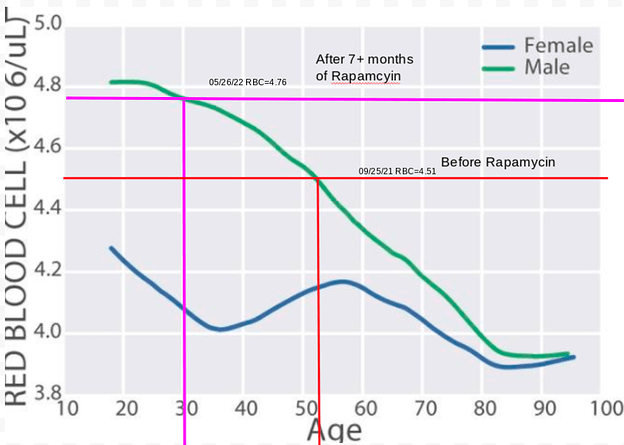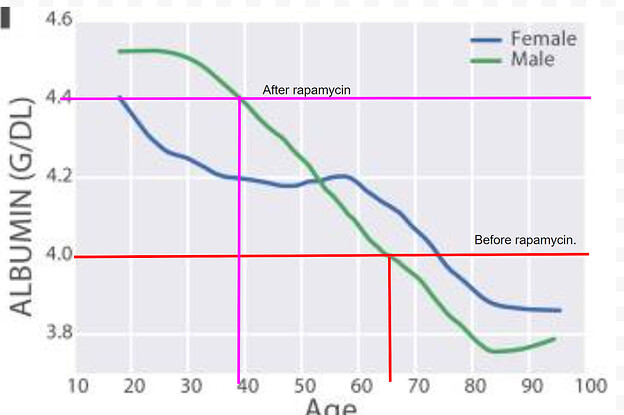“Have you noticed other kidney/liver markers decreasing?”
Which ones do you refer to?
Of course, I had to look up some possible other causes. One is the lowering effect of coffee and I drink a fair amount of black coffee, typically 4, 11 oz mugs per day. As I said this is a first-time uric acid test for me. I wonder if there are other markers I haven’t been testing that I should look out for.
Thanks for the reply.
I have been doing lipids panels and CBTs and CRP so that can fill in my Levine Age Test spreadsheet.
For kidney, eGFR, Uric Acid, Serum Creatinine, BUN
I think you shared iron panel, ferritin.
Looking at the Sirolimus/GFJ study, you’re covering pretty much a full range of side effects markers.
Some of my markers have taken a decided downturn since starting the higher dose of rapamycin. For example, My eGFR was 77 after four weeks at 5mg/week. My latest eGFR after taking 20mg/with grapefruit juice every two weeks for ten weeks is 59.
I am now doing a washout for a few weeks and see if they bounce back.
*“Bilirubin is the main pigment in bile and a major product of normal red cell breakdown. It is helpful in evaluating liver function, various anemias and in evaluating jaundice, yellowing of the skin”
*“The BUN/creatinine ratio is a calculated value derived by dividing the urea nitrogen result by the creatinine result. This ratio can be helpful in determining whether elevated urea nitrogen is due to impaired kidney function or to other factors such as dehydration, urinary blockage or excessive blood loss.”*“Estimated Glomerular Filtration Rate (eGFR) is a test for kidney damage. eGFR is calculated using your serum creatinine result, age and gender. Creatinine is not sensitive to early renal damage since it varies with age, gender and ethnic background. If you are African American, your eGFR is estimated differently. Since race is not reported in this screening, you will need to use the reported result that is associated with your race. To get a African American specific result, you can multiply this result by 1.21 to get your true eGFR. The same reference ranges will apply.”
*Quotes are from Quest Diagnostics
I think Total Bilirubin and Bun/Creatinine is ok.
You want eGFR going up.
How about ALT, AST, GGT?
@Russ_Mortensen are you still tired and dragging? I feel this too recently. Wanted to see if it is an adjustment period thing.
I think adjustment period. Not experiencing it anymore.
Age: 64
Health: No major health issues. Minor health issues include GERD, aches/pains, sciatica, and tinnitus.
Sirolimus Use: Completed first 8-week trial with 1 mg/week ramp-up to 5 mg/week; 30 mg total.
Positive Observations: Scalp actinic keratosis greatly improved. General minor aches/pains and tinnitus improved.
Negative Observations: Possible waves of short-duration fatigue and slower food transit times.
Blood Test 5-days after last trial dose: All normal results except for lymphocytes (49.8%) and absolute neutrophils (1.48x10(3)/uL).
Next Steps: After 6-7 week washout period and will run another CBC. If abs neutrophils are within my normal range, I will try a 8-week trial at 3 mg/week.
Question: Have any of you experienced low abs neutrophils from sirolimus use? If so, please provide any insights learned.
I’m not sure sirolimus has much or anything to do with ABSOLUTE NEUTROPHILS as mine has varied all over the place in the last few years. After two months of sirolimus in higher doses than you are taking, they went up. Four months later they went down. The same with ABSOLUTE LYMPHOCYTES. There are so many variables that affect these measurements I can’t tell at this time if sirolimus has any effect.
As I am one who has had an actinic keratosis skin problem, I can tell you mine have completely cleared up after about seven months of rapamycin intake.
“Elevated UA levels have also been associated with hypertension and upregulation of the renin–angiotensin system.” i found this to be true. My family doctors prescribed various BP-lowering drugs like lisinopril, valsartan, amlodipine and metoprolol, none work better than allopurinol, a drug for lowering uric acid. Now i am taking only allopurinol once daily and my BP is about 120/80 .
https://www.ncbi.nlm.nih.gov/pmc/articles/PMC2684336/pdf/nihms109058.pdf
desertshores: Thank you for your response and also the lab data you have posted to other forum topics.
I had this for around 10 years. As soon as I removed all seed oils from my diet it disappeared within a week, and it has never come back. (This was long before I started any other interventions so it could only be down to the seed oils (sunflower, safflower, rapeseed, sesame seed, canola).
I am 3 months in - been taking 6mg once a weekly (started at 1 and slowly increased) of Sirolimus bought through Varun Medicals. So far experienced pretty bad fatigue, recovery from exercise went from 2 days to 5 days, muscle pain especially legs and my lymph nodes sometimes get enlarged for no reason. Also, definitely more “bumps” on eyelids.
It is actually very concerning because so far I have not experienced any of the positive effects (energy, less pain, weight loss), actually quite the opposite. I am beginning to question what is it I am actually taking… Unfortunately, i don’t have the means to test the pills where I live.
Certainly unusual. Those symptoms sound inflammatory but rapamycin is anti inflammatory so I’m wondering if it’s an allergic reaction. Sometimes the allergic reaction can be to fillers or coloring like red or blue.
Symptoms could also be viral as some viruses can be very long lasting, though it shouldn’t occur just when you take the drug.
It might have been coincidental and indeed some sort of a virus or long-COVID.
The bad symptoms started at 6mg so I wonder if I should decrease it back to 3-4mg…
Did you start at 6mg or did you slowly build up to it?
It sounds like you may want to take a break for a few weeks to see if it is coincidence, then start low at 1mg, then slowly increase by 1 mg per week. Slowly increase dose at beginning may lower side effects.
RPS: Thank you for your response; I eliminated seed oil from my diet a few years back. Based on my recent prior lab results and close monitoring/optimizing of diet/exercise/sleep, I think my low number of abs neutrophils is due to the sirolimus. I have started studying about the pharmacokinetics of sirolimus and now understand that the sirolimus could be the cause of my lower count. There appears to be a clear dose response curve. I will get another baseline CBC and then try a lower sirolimus dose.
There have been some people asking questions as to the benefits of rapamycin. Some people have been disappointed in the perceived results. The best thing is to track your results using the most common blood tests, such as CBC, etc. I use ““https://www.walkinlab.com”” to order my own tests from time to time.
I was 81 yrs. old when I started to use rapamycin and I was already in pretty good shape for my age. I have been exercising on and off my whole life and very regularly since 2006. There are many supplements that I have been taking for years. So, I didn’t experience any profound subjective benefits, quite the opposite. As others have posted, I feel less energy for the first few days after taking rapamycin. I have experimented with weekly and bi-weekly dosing and feel better with the bi-weekly dosing. At my age, I definitely feel higher dosing is right for me.
Using charts that Michael Lustgarten of Youtube uses to determine if his markers are going in the right direction and ones that appear on the Levine Phenotypic calculator. I will post some of the markers I feel rapamycin has changed the most. Here is the first. You will see that this age marker changed from~52 yrs. old to 30 yrs. old.
RBC
Wang Z, Li L, Glicksberg BS, Israel A, Dudley JT, Ma’ayan A. Predicting age by mining electronic medical records with deep learning characterizes differences between chronological and physiological age. J Biomed Inform. 2017 Dec;76:59-68. doi: 10.1016/j.jbi.2017.11.003. Epub 2017 Nov 4. PMID: 29113935; PMCID: PMC5716867.
Thanks for that. Always interesting to see some rapamycin data.
Still another result from taking rapamycin for ~7 months when this test was taken.
Though this doesn’t make a big difference on the Levine phenotypic spreadsheet calculator, I am very surprised at the huge difference it makes compared to typical age-related amounts.
Have any other rapamycin users on this forum experienced a change in their albumin levels since they started rapamycin?
Wang Z, Li L, Glicksberg BS, Israel A, Dudley JT, Ma’ayan A. Predicting age by mining electronic medical records with deep learning characterizes differences between chronological and physiological age. J Biomed Inform. 2017 Dec;76:59-68. doi: 10.1016/j.jbi.2017.11.003. Epub 2017 Nov 4. PMID: 29113935; PMCID: PMC5716867.





